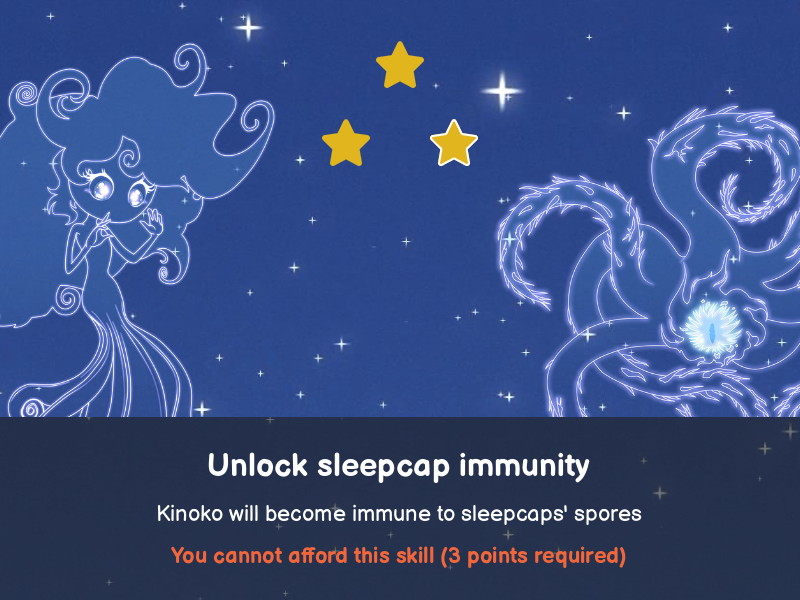Exploring enemy types
Published by James on 07/08/2023Welcome to a new month, and to a new blog post from the Kinoko and the Cult of Galaxy team! It’s still chucking it down in England, so we’ve been just as busy as ever, stuck indoors, freezing, working on our game and producing more of the content you all seem to be enjoying!
Before we get into the main point of this blog post, I have some personal news to share: we bought a house! This has been a goal of mine for many years, so it feels good to finally be able to say we’ve done it. It’s been a long and expensive process – one which we started just a little under three months ago – but we finally paid up and exchanged contracts at the beginning of last week. That means it’s now a done and legally-binding deal, and we’re just waiting to get the keys, which we’ll be doing at the end of August. Don’t be surprised if we go quiet for a little bit then (the house doesn’t even have a phone line installed yet!), but we’ll be doing our best to preemptively make up for it over the next three weeks.
Of course, if you’ve been following us on Twitter you’ve probably heard that Chelsey’s laptop died just after we paid up our entire life savings, which is just typical. Obviously the money we’ve raised for the game is in a separate pot, we don’t touch that for things like this. Chelsey’s thankfully received several commissions and several very generous donations since then, and I’ve dug an old laptop out from the cupboard so she can get to work on those jobs whilst we continue to save. It’s not the best laptop in the world (it was in the cupboard for a reason) but it’ll enable her to work on commissions until we’ve recovered from the financial setback of the house and earned some more money.
Anyway, onto the topic of the day… exploring enemy types.
Firstly, if you haven’t seen it yet over on our YouTube account, here’s a quick video overview which briefly introduces three of the different enemy types I’ve prototyped so far. I suggest watching it first, as it’ll illustrate a lot of what I’m about to write next!
Whilst Chelsey’s focused on the bosses – which are going to be the more action-packed, character-driven encounters, and which we’ll talk about more some other time – I’m focusing on the game’s generic mobs. These are the types of enemies that may appear several times throughout a planet.
When coming up with new ideas for generic mobs, the first thing I try to think about is what their basic behaviours might look like, and if these could maybe be used for any other enemy types later. Since we’re looking at having at least five planets playable in this game, it’d be really time-consuming if we had to build each and every enemy entirely from scratch. That’s why I’m looking at a ‘mechanics-first’ approach. If I can build an enemy today with a solid ‘follow’ mechanic for example, then I can likely re-use that for other enemies on other planets, and I’ll save a bunch of time next time an enemy needs to be able to follow Kinoko.
In the video above, you will have seen three: a plant, a spider, and a mushroom.
Let’s quickly take a look at them one-by-one!
The plant enemy
The carnivorous, kuparkuke-eating plant was the first proper idea that came to mind when looking to add a repeatable enemy type. Quite a lot of games have an enemy type like this, so you probably know how it works even if you haven’t watched the video. Get too close and it’ll bite; avoid its bite and you’ll get a brief window of opportunity to shoot it whilst its defences are down.
If you read our previous blog post on starsprites (our game’s answer to health and power-ups) you’ll know already that, by surrounding himself with them, Kinoko can effectively carry multiple lives. A single starsprite can protect you from a single bite, but if Kinoko doesn’t have any then he’ll be swallowed whole and you’ll get hit with an instant ‘game over’! Although we don’t have many real graphics yet in our game, we envision these enemies as being something that’ll sort of blend into the background a bit and not always stand out until they strike – so you’ll need to keep your wits about you when exploring the mushroom jungle!
The spider enemy
The spider’s a bit more rough than the plant, and unfortunately you can’t actually see the web in the video because it’s a white line being rendered on a white base, but there is one, honest! Nevertheless, I quite like the simplicity of this concept. The spider remains dormant in its nest until Kinoko comes near. When he does, she’ll drop down on her web and hang in the air for a moment, taking the chance to attack Kinoko if he’s in range, before quickly scuttling back up to safety.
Similarly to how the plant is intended to sort of blend in with the environment art, the spider is designed to appear out of view in the mushroom and treetops. Only when Kinoko comes near will they suddenly drop into view, so, again, they’re something you’ll need to look out for. For the sake of demonstration, the video shows the spider just hanging there in mid-air with zero coverage, but you can expect that to change once some real environment art comes along.
(FYI, I drew the sprite for this one, but I know that Chelsey has an interesting mushroom-based design up her sleeve for this enemy!)
The mushroom enemy
And lastly we have the mushroom enemy. I’m not 100% decided on what I’m actually going for with this one yet, aesthetically-speaking, but in my mind this enemy is a little bit like a zombie, only it’s not actually undead. It’s like a sort of weird fungus monster which has come magically to life. Anyway, this one slowly shambles towards Kinoko and has a lot of hitpoints, so the only way to kill it is to keep a distance (using its bouncy mushroom head for help!) and get as many shots in as you can before it kills you. It’s a more ‘tanky’ enemy than the others, but still fairly simple to defeat.
This enemy isn’t designed to be hidden like the other two, but I thought it would be a nice effect if it rises headfirst from the ground when Kinoko comes close. That’s something you can see in the video. It’s a slow effect, so it does give the player some time to prepare.
Also, fun fact, I designed, drew and even animated this one myself (though I’ve no doubt that Chelsey will design it to look a thousand times better and way more original than I have, when she gets around to it, still I didn’t think my attempt at a walk cycle was actually that bad)!
Future enemy types
So, there you have it – the first three generic, repeatable enemy types for our game! I don’t know for sure if they’ll all make the final cut, or even if any of them will. More than anything else, these first three enemies have been a learning experience for me. I might improve them, or I might end up replacing them with something even better. I’m looking at about ten enemies minimum for Fungaia, though with several subregions to explore – such as forest, jungle, caves, tribal villages, alien encampments and more – it’ll likely end up being more than that, and that’s just one planet out of five minimum. I’ve got my work cut out for me here!
I’ve got a couple more in the works currently – there’s a bird enemy, which wasn’t quite ready to show off in today’s video, but which I definitely intend to finish, and there’s also an alien poacher enemy, which is the most complex of the lot, since he can respond to your actions, for instance by switching between offensive and defensive states. We’re definitely going to need more blog posts on this topic when I’ve got more enemies to show off, and there’ll be more videos too, so make sure you subscribe to our YouTube channel if you don’t want to miss out on those.
Anyway, I think that’s enough for today’s update. As I explained earlier in the post, we’ll be busy moving into our new house at the end of this month and the beginning of September, and Chelsey’s now got a bunch of your commissions to do so that she can replace her dead laptop, so for both of those reasons there’s a chance we might get a little bit quiet for a short time over the coming weeks (one of the reasons I’m making sure I get this month’s update out of the way nice and early!), but we’re going to working extra hard this month to make up the difference, so progress probably won’t even take a hit!
As always, take care, and don’t forget to check our links page for all the ways to follow our work!




